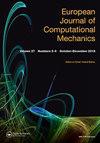Structural Dynamics of Bridges Under the Coupling Effect of Windmills and Bridges
IF 0.6
Q3 MECHANICS
引用次数: 1
Abstract
To analyze the coupled dynamics effects of existing railroad frame bridge structures under the action of traffic, a coupled train-ballast track-suspension bridge girder-soil dynamics model is established based on railroad large system dynamics and finite element theory. The joint ABAQUS-MATLAB simulation, time-varying coupling, and multi-step dynamic iterative solution strategies are introduced to numerically simulate the mechanical properties of existing railroad structures under the coupled effects of wind loads and traffic action. Specifically, (1) a dichotomous method is proposed to investigate the static behavior of the bridge in the bridge-forming state, and the maximum upper arch of the stiffened girder is 3.67 cm, which occurs at about 1/4 and 3/4 positions of the main span, and the lower deflection of the side span is larger, and the maximum lower deflection occurs at 11.04 cm in the span of the 110 m side span. The vertical acceleration in the span increases immediately with the maximum peak of 30 cm/s2, while the lateral acceleration is maintained within 20 cm/s22. (2) The effects of the stiffness of the rail fasteners and the bridge plate support stiffness on the dynamics were studied. (3) The results of the time-domain analysis are in general agreement with the simulation data, except for the error of the ambient vibration background existing at the peak. The correctness of the simulation model is verified.风车与桥梁耦合作用下的桥梁结构动力学
为分析既有铁路框架桥梁结构在交通作用下的耦合动力效应,基于铁路大系统动力学和有限元理论,建立了列车-道砟轨道-悬索桥梁-土耦合动力模型。采用ABAQUS-MATLAB联合仿真、时变耦合和多步动态迭代求解策略,对既有铁路结构在风荷载和交通耦合作用下的力学性能进行了数值模拟。具体而言,(1)采用二分类方法研究了桥梁在成桥状态下的静力性能,加劲梁的最大上拱为3.67 cm,发生在主跨的1/4和3/4位置左右,侧跨的下挠度较大,110 m侧跨的最大下挠度发生在11.04 cm。跨内竖向加速度立即增大,最大峰值为30 cm/s2,横向加速度保持在20 cm/s2以内。(2)研究了钢轨扣件刚度和桥板支撑刚度对动力学的影响。(3)时域分析结果除峰值处存在环境振动背景误差外,与仿真数据基本一致。验证了仿真模型的正确性。
本文章由计算机程序翻译,如有差异,请以英文原文为准。
求助全文
约1分钟内获得全文
求助全文

 求助内容:
求助内容: 应助结果提醒方式:
应助结果提醒方式:


